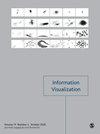StoryFacets:一项关于协作数据分析的可视化故事的设计研究
IF 1.8
4区 计算机科学
Q3 COMPUTER SCIENCE, SOFTWARE ENGINEERING
引用次数: 10
摘要
在许多数据分析工具中,跟踪语义生成过程是一种成熟的实践,许多可视化工具有助于在探索期间和之后进行概述和回忆。然而,最终的交流材料,如演示文稿或信息图表,为了简单起见往往省略了出处信息。不幸的是,这限制了后来的观众参与进一步的合作意义构建或关于分析的讨论。我们提出了一项设计研究,我们将视觉来源和分析引入城市交通规划。维护所有分析的来源对于支持众多不同涉众之间的协作意义生成至关重要。我们的系统,STORYFACETS,公开了同一分析会话的几个不同视图,每个视图都是为特定的受众设计的:(1)跟踪视图提供了一个数据流画布,支持深入探索+来源(专家分析师);(2)仪表板视图将可视化和其他内容组织到一个填充空间的布局中,以支持高级分析(管理人员);(3)幻灯片视图支持通过交互式分步演示(外行人)进行线性讲故事。视图是链接在一起的,这样当一个视图发生更改时,就可以维护其来源。可视来源可以根据需要支持任何团队成员的迭代意义。本文章由计算机程序翻译,如有差异,请以英文原文为准。
StoryFacets: A design study on storytelling with visualizations for collaborative data analysis
Tracking the sensemaking process is a well-established practice in many data analysis tools, and many visualization tools facilitate overview and recall during and after exploration. However, the resulting communication materials such as presentations or infographics often omit provenance information for the sake of simplicity. This unfortunately limits later viewers from engaging in further collaborative sensemaking or discussion about the analysis. We present a design study where we introduced visual provenance and analytics to urban transportation planning. Maintaining the provenance of all analyses was critical to support collaborative sensemaking among the many and diverse stakeholders. Our system, STORYFACETS, exposes several different views of the same analysis session, each view designed for a specific audience: (1) the trail view provides a data flow canvas that supports in-depth exploration + provenance (expert analysts); (2) the dashboard view organizes visualizations and other content into a space-filling layout to support high-level analysis (managers); and (3) the slideshow view supports linear storytelling via interactive step-by-step presentations (laypersons). Views are linked so that when one is changed, provenance is maintained. Visual provenance is available on demand to support iterative sensemaking for any team member.
求助全文
通过发布文献求助,成功后即可免费获取论文全文。
去求助
来源期刊

Information Visualization
COMPUTER SCIENCE, SOFTWARE ENGINEERING-
CiteScore
5.40
自引率
0.00%
发文量
16
审稿时长
>12 weeks
期刊介绍:
Information Visualization is essential reading for researchers and practitioners of information visualization and is of interest to computer scientists and data analysts working on related specialisms. This journal is an international, peer-reviewed journal publishing articles on fundamental research and applications of information visualization. The journal acts as a dedicated forum for the theories, methodologies, techniques and evaluations of information visualization and its applications.
The journal is a core vehicle for developing a generic research agenda for the field by identifying and developing the unique and significant aspects of information visualization. Emphasis is placed on interdisciplinary material and on the close connection between theory and practice.
This journal is a member of the Committee on Publication Ethics (COPE).
 求助内容:
求助内容: 应助结果提醒方式:
应助结果提醒方式:


